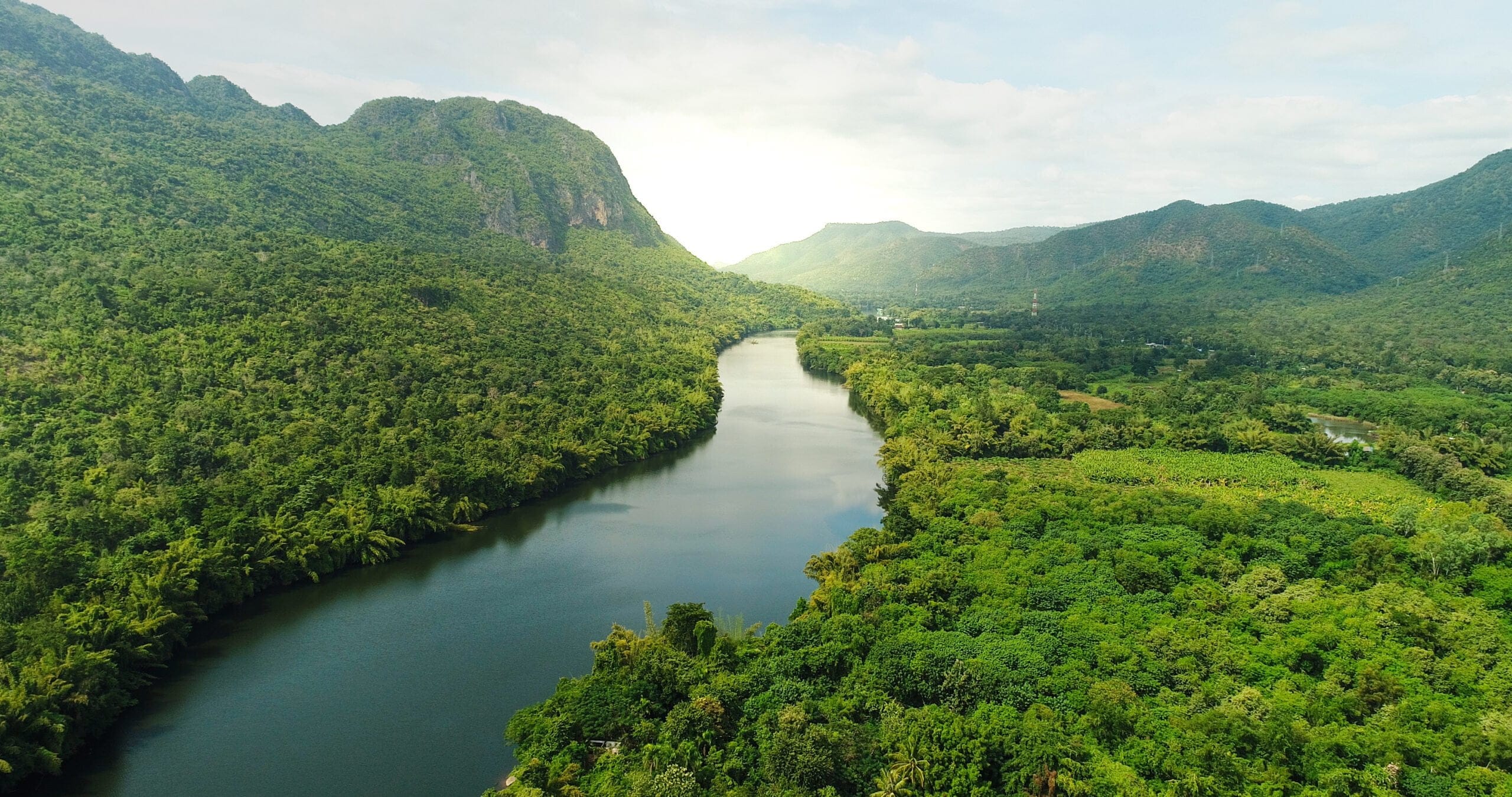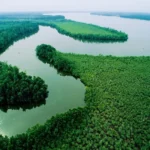Embark on an unforgettable journey along the Yangtze River, the undisputed king of rivers in Asia. This awe-inspiring waterway, stretching over 3,915 miles, originates from the Tibetan Plateau’s snowy heights and gracefully winds its way eastward, finally merging with the East China Sea. Along its course, the Yangtze meanders through some of China’s most captivating landscapes, serving as a lifeline for millions and playing a crucial role in shaping the nation’s history and culture.
Asia’s Longest River: The Yangtze
When we talk about Asia’s most impressive rivers, the Yangtze, often referred to as the “Chang Jiang” in China, reigns supreme. Spanning an incredible distance of over 6,300 kilometers (nearly 4,000 miles), it claims the title of Asia’s longest river and secures its position as the third longest river in the world.
The Yangtze’s reach is not merely impressive in terms of length; it flows entirely within China, a testament to the country’s vast size and the river’s profound influence. To put this into perspective, the Yangtze supports a population larger than the entire United States, highlighting its importance as a source of water, food, transportation, and economic activity.
However, Asia is a continent blessed with a network of remarkable rivers. The Mekong, for instance, embarks on a transboundary journey through several Southeast Asian countries, acting as a unifying force. Then there’s the Yellow River, celebrated for its distinctive yellowish hue resulting from sediment load and its significance in China’s environmental restoration endeavors.
The rivers of Asia, particularly the Yangtze, are more than just bodies of water. They are lifelines for billions of people, providing:
- Drinking water and irrigation: Sustaining life and agriculture
- Transportation routes: Enabling trade and connectivity
- Habitat for diverse flora and fauna: Supporting rich ecosystems
Therefore, the Yangtze, as the biggest and arguably the most impactful river in Asia, exemplifies the crucial role rivers play in molding a region’s culture, driving its economic growth, and preserving its environment.
What are the 5 main rivers in Asia?
Asia, with its sprawling landmass, is home to some of the most awe-inspiring rivers on the planet. These waterways have not only shaped civilizations but also sustained countless lives and continue to amaze us with their sheer scale. Let’s delve into five of the most prominent rivers gracing the Asian continent:
- Yangtze River (China): The undisputed champion, the Yangtze River, stretches over 6,300 kilometers (almost 4,000 miles). This mighty river, flowing through the heart of China, sustains over 400 million people residing along its banks, highlighting its significance in transportation, agriculture, and Chinese culture.
- Mekong River (Southeast Asia): While not as long as the Yangtze, the Mekong River holds immense importance, flowing through six countries: China, Myanmar, Laos, Thailand, Cambodia, and Vietnam. It serves as a lifeline, providing food, water, and transportation to millions, and harbors some of the world’s most diverse ecosystems, teeming with unique species like rare dolphins and giant catfish.
- Yenisei River (Russia): Journeying north to Russia, we encounter the Yenisei River, the fifth longest river globally, flowing over 5,539 kilometers (approximately 3,442 miles). Winding its way through remote and breathtaking landscapes, from the Siberian taiga to the Arctic tundra, the Yenisei offers glimpses of diverse wildlife and plays a vital role in the region’s ecosystem.
- Ob River (Russia): Originating from the Altai Mountains, the Ob River traverses western Siberia, eventually joining the Irtysh River to form a massive river system. This chameleon-like river flows through diverse landscapes, including lush forests, vast wetlands, and fertile farmlands. The Ob is a crucial waterway for transportation, fishing, and even oil and gas production.
- Lena River (Russia): Another Russian gem, the Lena River, holds the title of the longest river flowing entirely within Russia, spanning an impressive 4,400 kilometers (about 2,734 miles). Its journey takes it from the stunning Baikal Mountains to the icy Arctic Ocean, supporting diverse ecosystems and the communities inhabiting its banks.
These five rivers offer a glimpse into the intricate network of waterways that crisscross Asia. They are testaments to the continent’s biodiversity, provide livelihoods, and connect people and cultures in profound ways. Understanding these rivers allows us to grasp the essence of Asia itself.
What are the top 10 rivers in Asia?
Expanding our exploration of Asia’s impressive waterways, we delve into the top 10 longest rivers, recognizing their profound impact on the continent’s landscapes, civilizations, and ecosystems.
| Rank | River Name | Location | Approximate Length (km) | Interesting Fact |
|---|---|---|---|---|
| 1 | Yangtze River | China | 6,300 | Asia’s longest and the world’s third-longest river, supporting a population larger than the United States. |
| 2 | Yellow River | China | 5,464 | Known for its distinctive yellow-brown hue due to the massive sediment load it carries. |
| 3 | Mekong River | Southeast Asia | 4,909 | A transboundary river flowing through six countries, serving as a lifeline for people, wildlife, and economies. |
| 4 | Lena River | Russia | 4,260 | Originating in the Baikal Mountains, it journeys north to the Laptev Sea, showcasing Siberia’s vastness. |
| 5 | Irtysh River | Russia, Kazakhstan, China | 4,248 | Merges with the Ob River to create one of the longest river systems in Asia – the Ob-Irtysh. |
| 6 | Ob River | Russia | 4,039 | Flows through western Siberia, freezing over in winter before emptying into the Kara Sea. |
| 7 | Yenisei River | Russia | 3,986 | Known for its powerful currents, it drains a massive area in Siberia, showcasing the region’s abundant water resources. |
| 8 | Indus River | Pakistan, India | 3,180 | Has been central to the Indus Valley Civilization, one of the oldest in human history. |
| 9 | Nizhnyaya Tunguska River | Russia | 2,867 | A tributary of the mighty Yenisei River, playing a key role in its flow. |
| 10 | Brahmaputra River | China, India, Bangladesh | 2,880 | Known for its incredible power, especially during monsoons, merging with the Ganges to form a massive delta in Bangladesh. |
These rivers are not merely geographical features; they are powerful symbols of the interconnectedness of nature, culture, and history. Their health is paramount to the well-being of the environment and communities that rely on them. By understanding their significance, we can work toward their preservation for generations to come.
This list provides just a glimpse into the fascinating world of Asian rivers. Numerous resources are available for those eager to delve deeper into their unique stories and characteristics.
Which is the largest river in Asia MCQs?
While we’ve explored various mighty rivers, there’s no doubt that the Yangtze River stands as the undisputed champion in Asia. This colossal river spans over 6,300 kilometers, securing its position as the longest river in Asia and the third longest on Earth.
Imagine a journey commencing in the towering, snow-capped mountains of Tibet, where the Yangtze begins. Picture it snaking eastward, cutting through the heart of China before finally reaching the East China Sea. This epic voyage is the Yangtze’s story.
Beyond its impressive length, the Yangtze acts as a lifeline for millions. It serves as a source of:
- Drinking water: Essential for survival
- Water for farming: Supporting agriculture and livelihoods
- Transportation routes: Enabling trade and travel
- Fish and other resources: Providing sustenance and economic opportunities
The city of Chongqing, situated on the Yangtze’s banks, is home to over six million people, highlighting the river’s capacity to support large populations.
For centuries, the Yangtze has been woven into the very fabric of Chinese civilization. Its history, culture, and identity are deeply intertwined with this mighty river. Even today, the Yangtze’s role in China’s economy and the well-being of its people remains paramount.
Remember, the Yangtze is more than just a river; it’s a force of nature that has shaped a nation.
What is the world’s largest river?
Determining the “largest” river can be subjective, as there are different ways to measure size, such as length, water volume, or the area of the river basin. However, regarding sheer length, the Amazon River claims the crown. This incredible South American waterway stretches over 6,400 kilometers (almost 4,000 miles), surpassing the length of the contiguous United States.
The Nile River in Africa, historically considered the world’s longest, remains a close contender. Measuring the exact length of rivers, especially those winding through remote and challenging terrains like the Nile, can be complex. New research and advanced measurement techniques can sometimes lead to revised rankings.
Let’s not forget Asia’s Yangtze River, boasting a length of over 6,300 kilometers. It stands strong as likely the third longest river globally, holding immense cultural, economic, and ecological significance.
In essence, while the Amazon currently holds the title of the longest river, the debate over the world’s largest river is ongoing and subject to change with future discoveries and research. What remains undisputed is the vital role these incredible rivers play in our planet’s health, supporting biodiversity, sustaining communities, and shaping history.
Key Takeaways:
- Based on length, the Amazon River currently holds the title of the world’s largest river.
- The Nile River remains a close contender, with its historical claim and ongoing research potentially influencing its ranking.
- The Yangtze River, spanning over 6,300 kilometers, is likely the third longest river globally.
- Defining the “largest” river depends on the chosen metric, whether length, water volume, or basin size.
- Continuous research and evolving measurement techniques mean our understanding of these massive waterways is dynamic and subject to change.
Further Exploration:
- Delve deeper into the debate surrounding the world’s largest river, exploring the latest research on river lengths and the complexities of accurate measurement.
- Discover the incredible biodiversity and cultural significance of these mighty rivers, each with a unique and captivating story to tell.
Internal Links:
- The longest river in the world is the Nile River, which flows for 6,650 kilometers (4,130 miles) through northeastern Africa.
- The mouth of the river is the place where it meets a larger body of water, like a sea or ocean.
- The world’s widest river is the Rio de la Plata, which is 304 kilometers (189 miles) wide at its mouth.
- The longest rivers in Africa are the Nile River, the Congo River, and the Niger River.
- The widest river in the world is the Rio de la Plata, which is 304 kilometers (189 miles) wide at its mouth.
- The two largest rivers in the US are the Mississippi River and the Missouri River.
- Unveiling the Enigma: Mansoureh Khojasteh Bagherzadeh’s Public Appearances & Private Life in Iran - July 18, 2025
- Unveiling the Mystery: Mansoureh Khojasteh Bagherzadeh’s Husband: A Rare Glimpse into a Private Life - July 18, 2025
- Unveiling Masoud Khamenei’s Mother: Power, Influence, and Iran’s Future - July 18, 2025
















